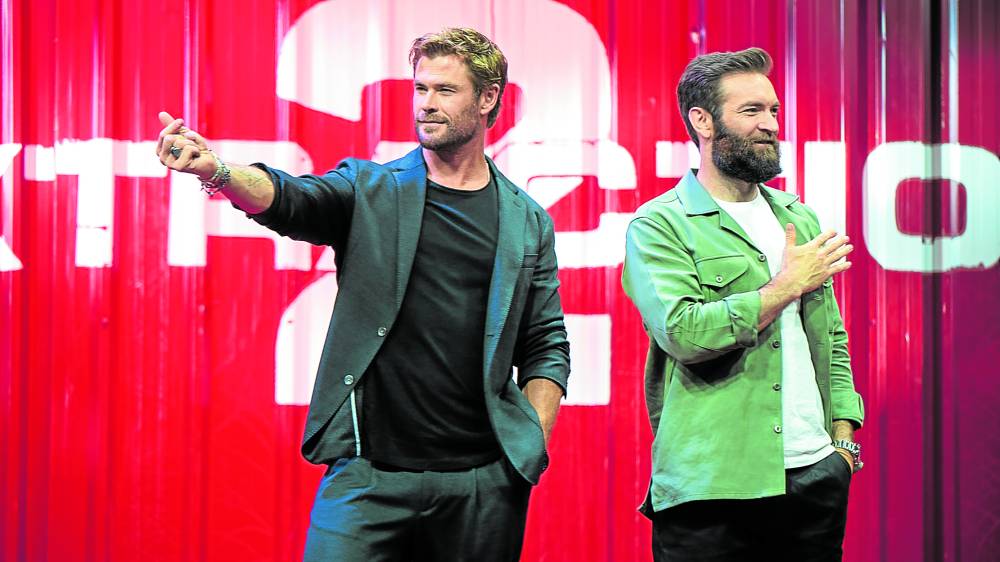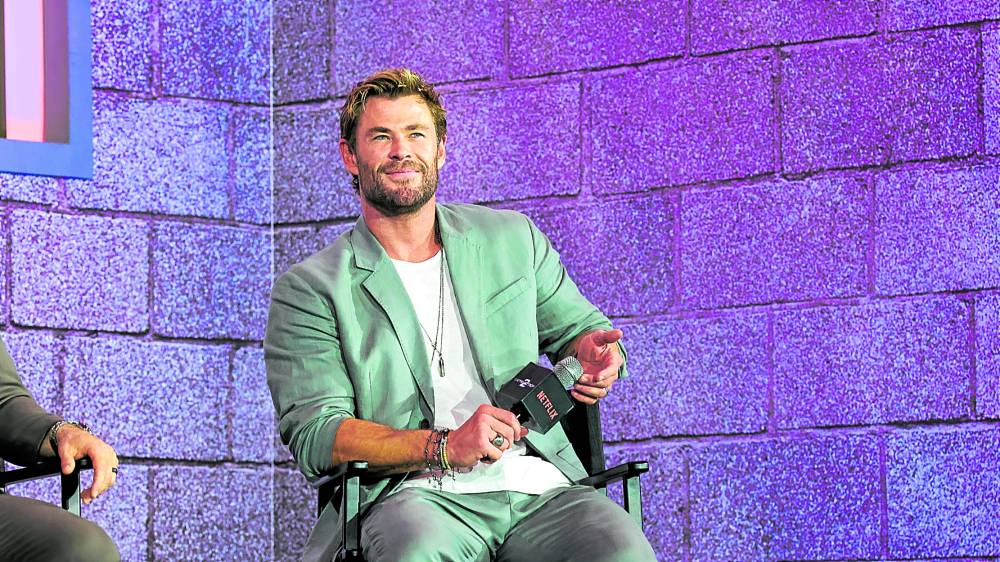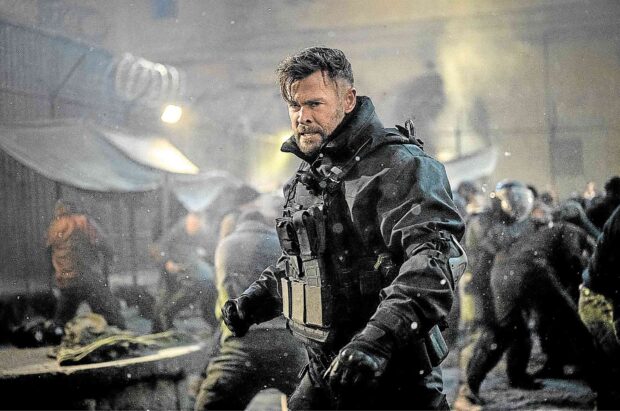Chris Hemsworth on resurrecting the dead, ‘real-time’ action and looking good
We’ve crossed paths with Chris Hemsworth a number of times in the past but have yet to see him lose his composure, look frazzled or get touchy over a sensitive, sensational or personal question.
He’s cool as a cucumber without seeming dismissive or defensive—like when he was recently asked to react to fans’ disappointment over those ‘silly’ moments from “Thor: Love and Thunder” or to Martin Scorsese and Quentin Tarantino’s less-than-flattering views about the Marvel Cinematic Universe (MCU).
The dashing 39-year-old movie star has always made covering his films and TV projects as exciting as it is breezy. He is kind without being obsequious and, unlike some of his previous costars, he doesn’t take himself too seriously.
At the roundtable interview with the Philippine press for Netflix’s “Extraction 2” at Conrad last Tuesday, however, we did see Chris flinch a bit out of embarrassment when he was asked to share tips on how to look as gorgeous as he does.
Even his similarly handsome director, Sam Hargrave—who, like his brother Daniel Hargrave, used to be Chris Evans’ stunt double as Captain America in “Avengers: Endgame”—couldn’t resist ribbing his lead star and having a good laugh about it!
Chuckling beside a momentarily speechless Chris, Sam quipped, “You can actually try to make Chris look worse, but he’s one of very few people who’ll only end up looking even better!”
It’s also that towering masculine “beauty” and brawn that make the actor convincing as his larger-than-life character Tyler Rake, who fought tooth and nail to endure countless explosions and mano a mano punches in 2020’s action-packed blockbuster, “Extraction.” Its eagerly anticipated sequel premieres on June 16 on Netflix.
While Chris is most famous for playing the god of thunder Thor in several MCU films, he was also part of other high-profile franchises, like “Star Trek,” “The Huntsman” and even “Ghostbusters.”
When we asked him what he thought sets the “Extraction” movies apart from his other franchises, he explained, “There’s [more] authenticity to it, particularly with its visuals and the action taking place in the real world. So much of what you see in this film is actually caught on camera … they’re orchestrated, designed by sound to be captured in the moment and on the day, as opposed to shooting a scene on a green screen and then, a few months later, you head off to postproduction to fill it in.
Truthfulness
“So there’s really a truthfulness to it. A lot of the larger blockbuster films that are heavily influenced by—or heavily covered in—special effects are missing that [element of authenticity]. For me, even in the actual shooting of it, it brings out a different performance from myself.
“I think this is true for all actors: You can fake it as much as you want in front of a green screen, but it will never look as authentic or as real as it does if you’re [shooting a scene] literally running on top of a train or speeding car. You’re sweating, you’re breathing heavily and things are on fire—and your whole body reacts to that in a far more spontaneous and visceral way.”
The film owes all of the action series’ “real-time,” nonmanufactured, no-effects-driven adrenaline rush to Sam’s influences as a teenage movie buff geeking over the Hong Kong actioners of yore.
“I appreciate you noting the things [in the film] that haven’t been seen by viewers before,” Sam said to the articulate journalist beside us who asked about his early influences in action. “It’s really difficult in this day and age to do something like that, because there are a lot of great action movies done by so many great action directors, fight choreographers and action designers. So, to stand apart is the biggest challenge that I often face as an action director.
Experiential style
“A lot of my inspiration comes from old Hong Kong cinema. My spirit, my soul, has been inspired by all that since I was 14 or 15 years old, when I started watching the movies of Jackie Chan, Jet Li, Yuen Biao [and] Samo Hung—all of these guys used action as a storytelling device because they couldn’t keep up with the computer-generated or special effects of Hollywood.
“For them, it was like, ‘How can we differentiate ourselves?’ They did it through physical movement and stunts performed by the human body—and a lot of that is ingrained in me. So, when I’m trying to come up with stuff for these movies, a lot of it comes from what’s real. It’s not like, ‘Oh, we can do this in visual effects!’
“Like, how do we put Chris Hemsworth on a train rather than on a green screen …? Let him feel the cold wind. Let’s see the helicopter in front of him, just 20 feet away, and let the audience experience that adrenaline rush as well.
“It’s more experiential than it is a third-person account. You’re not just sitting back and watching—instead, you feel you’re part of the action. That’s the kind of style that I want to experience as a viewer, so I try to pay that forward to other audience members.”
As for the reason behind bringing Tyler Rake back from the dead, Chris explained, “While we were shooting the first one, we discussed the possibilities of where the character in this franchise could go, but we didn’t know if we were going to have the opportunity to do a sequel.
“Originally, the character died—and that was it as a finite conclusion to the film. In fact, we were pretty adamant about Tyler Rake dying. We thought we’d be better off if we just completed it there. And then, we had all this wonderful feedback and enthusiasm about what we were capturing on-screen.
“And they said, ‘Look, you’re crazy not to give yourself the option to have a sequel.’ So, we shot that little [scene at the end] where you see that blurry figure in the background—which gives the audience a hint that maybe Rake is alive.
“Once we shot that bit, we started discussing where the character could go, and that’s when we realized we hadn’t really explored the depth of his character onscreen. We had talked about it in length in preparation for the lead-up, but there was only one scene in the film where Rake is seen talking to Ovi (Rudhraksh Jaiswal) about his past, having left his son while he was dying, losing him and so on.
“That was almost like an origin story in itself, because we hadn’t done that in the first film. We didn’t tell the audience all the details we had up in our heads. So that’s unique for a sequel. Oftentimes, you have the arc of your hero; you know how broken he is. Then, he has to learn the truth about who he is, why he’s there, and why he should become the hero he’s meant to be. But then again, we still had the character fairly broken at the end of the film; that’s why we killed him (laughs). This time around, we had the opportunity to explore those themes in greater detail.”
Stunt experience
In a separate 20-minute clip, we’ve seen the difficult situations the camera-wielding Sam had to hurdle to catch the urgency and fast-paced action.
Asked to discuss the degree of difficulty of shooting those sequences, Sam disclosed that that was when his experiences as a stuntman and stunt double came in handy.
“There’s some great behind-the-scenes footage that I was reviewing this morning, and Netflix is going to release [it] at some point,” he revealed. “But to list some of them, there’s one where I had to traverse the top of a moving train and walk underneath a helicopter that’s just three feet away from me.
“I also had to strap myself to the front and back of moving vehicles. Another time, I was strapped onto wire rigs and dropped from the second story to the ground floor so I could follow the action.
“That’s a lot of crazy stuff, but they’re nowhere crazier than the things that I did as a performer. But I think that background has really enabled me to do some of those things, so I could put the camera where you’re not supposed to see it in action movies.”
Those were tough questions, indeed. But perhaps “harder” than any of those hurled at Chris was the one about his good looks and what other grooming tips other people could do to approximate the actor’s physical pluperfection—even when he’s sweating and all covered with mud.
“Thank you for that … feedback,” Chris answered tentatively. “Well, you just got to have Sam behind the camera to make sure that he captures all your good angles (laughs). But for this film, there is a lot more pruning and prepping of the look and imagery [rather than how the actors in it should look]. Here, it’s more, ‘dirty it down, dirty it down,’ and scars and blood and sweat and so on.”
Interjecting, Sam then directed us to look at a poster of the film that shows Chris’ arms on fire. “Just look at him—he’s really hot (laughs)! We lit him on fire—eight times—and with blood all over him, but it only makes Chris look more handsome and macho in the photos. It’s ridiculous!”
As resounding laughter reverberated around the room, Chris tried to get the last word: “It’s amazing what some lighting and good music can do.”


